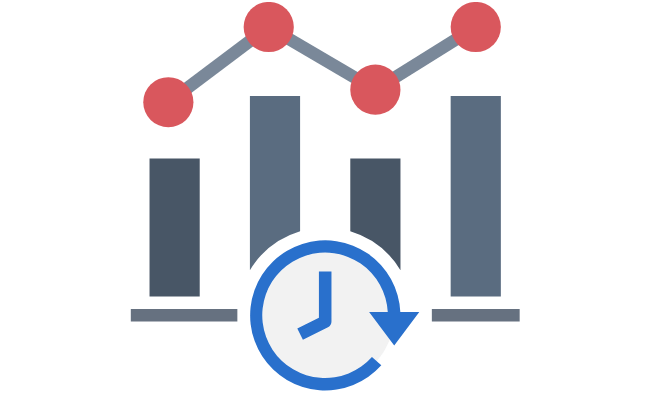Data is an invaluable piece of your manufacturing company when utilized correctly. I can’t stress enough how important it is and continues to become for manufacturing companies to adapt to the changes in the industrial landscape and strive to become data-driven organizations.
As funny as it is to say, the data backs it up. Data says that becoming data-driven is extremely beneficial for any company, especially manufacturers. In manufacturing, there is just so much information left on the table. There are so many moving parts and people at any given time. With that amount of constant movement between all of the machines, people, products, materials, and equipment; there is inevitably an enormous amount of waste, whether that waste is physical scrap or simply wasted movement. There is always a lot of room for improvement, and it starts with tracking these metrics and processes.
We believe the benefits of data-driven decision-making are extremely valuable, and data-driven manufacturing should not be viewed as just a “nice extra” for the companies that want to do more today. We believe that adopting data-driven tendencies will be required in the not-so-distant future for any company that wants to grow and succeed. Let’s get into some specific benefits that come along with data-driven decision-making.
1. Ability to Develop a Competitive Advantage
Competition in every industry continues to increase every year, every month, every day. Companies are constantly struggling to keep up and find ways to get ahead of the curve. However, there are of course numerous ways for companies to compete and succeed. One way to succeed today is to create data asymmetry in your market. Data asymmetry allows you to ask questions and get answers that the competition can’t. Well-known successful Companies like Google, Uber, Facebook, and Airbnb use data asymmetry to develop a unique competitive advantage- you can do the same.
2. Confident Business Decisions
Data gives you the substance to make confident decisions on a consistent basis. A confident decision leads to real action, not just a conversation that never gets anywhere because of some uncertainty. You need to have full confidence in the decisions you make to carry them out. With that being said, the real value comes when you enable yourself to take action.
3. Data Enables Action
Companies will succeed not only due to their competitive advantage that is driven by data. They’re also winning because they’re able to “USE the data most effectively”. Making good decisions comes from:
- Having a good process for solving problems, and
- Having data and related tools to find answers and solve those problems.
Once the decision is made then it’s time for Action. Nothing happens without taking action.
4. Improved Plant-Floor Efficiency
What gets tracked gets improved.
If you could track and gather insights on downtime, downtime reason codes, which operator was running the machine at what time, how long the shift was, what product was being run, scrap, throughput, operator changeovers, product changeovers, would that information be useful? Of course it would!
Without the data, you would be going in blind. Or at best, basing your decisions on a gut feeling or past experiences. This might have been a viable approach some years ago, but today in 2021 there are too many resources available that are much better options. If you don’t take advantage, somebody else will, and whoever does will be the one who continues to grow and find success in this competitive industry today. There is ALWAYS someone trying to do your job better, faster, cheaper, and willing to put in the effort to get there.
5. Cost Savings
Cost savings go hand in hand with improving efficiency. Improved efficiency means less waste and consequently, less cost. You will really start to see a difference when you improve inefficient processes to take less time and start capturing insights on scrap and downtime to reduce waste. Use data to combine reducing costs + improving efficiency to get more done in less time, with what you already have. Eliminate and reduce unnecessary movement and scrap by implementing data-driven decision-making.
6. Company Culture
Along with implementing data-driven decision-making, you need to establish a unified data-driven culture. For more in-depth information on the journey to creating a data-driven culture, check out this blog post. The post touches on the 5 facets of a data-driven organization as well the 4 stages most companies go through on their way to becoming a truly data-driven organization.
Establishing a data-driven culture can make a huge impact. Employees will be more involved, be enabled to be proactive, have access to the same information as everyone else, and everyone will be on the same page.
Having access to the same data acts as a communication tool in a way. Good communication is an important aspect of any relationship – whether it’s work-related or not; good communication keeps people happier, creates less confusion, and promotes an efficient environment.
This helps create a real team within the company, rather than sectioned off people or departments with their own silos of data doing their own thing. More often than not, those data silos and cliques within the organization end up hindering other departments. Each separate department should act as a service organization for the others, rather than a roadblock in the way making things harder than they have to be.
7. Improved Capacity to Scale and Grow
Numerous studies show that simply setting goals makes people much more productive, and people that plan better and stick to goals end up reaching those goals much more often.
Being data-driven and equipping yourself with the right tools and technologies grants you access to the metrics you need to be able to set goals and measure results. Set goals, stick to them, and work towards them each day. Data makes it much easier to make seemingly small, incremental adjustments continuously. This creates opportunities to execute new ideas, measure results, and either keep the course or change plans very quickly. Real-time data makes organizations much more agile and open to growth.
Final thoughts on Data-Driven Decision-Making
Starting a data-driven approach does not all need to take place all at once or be a complete overnight flip. It surely doesn’t mean that you should start to completely dismiss intuition and opinions. Although becoming data-driven is extremely important, we don’t want to give off the impression that past experience and common sense are “outdated” or have no place in the modern workplace.
Transitioning into a data-driven organization means that data should drive the majority of the workflow. Leadership should make data-driven decisions and carry them throughout the entire company. When this happens, everyone benefits.
Also, don’t forget that a data-driven approach is not only for the top 1% of companies and massive corporations. Any sized company can start today and begin the journey towards becoming a completely data-driven organization and reap the benefits.
Starting now, and being ahead of the curve will be greatly beneficial for increasing efficiency and improving company agility.
Start small, think big.













